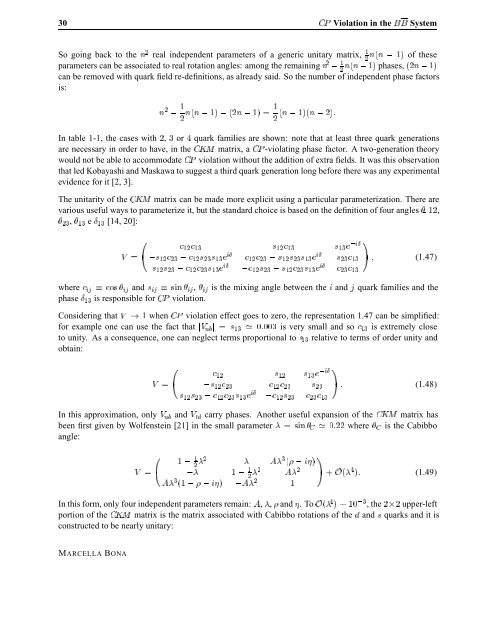Violation in Mixing
Violation in Mixing
Violation in Mixing
Create successful ePaper yourself
Turn your PDF publications into a flip-book with our unique Google optimized e-Paper software.
30 �È <strong>Violation</strong> <strong>in</strong> the �� System<br />
So go<strong>in</strong>g back to the Ò real <strong>in</strong>dependent parameters of a generic unitary matrix, Ò Ò of these<br />
parameters can be associated to real rotation angles: among the rema<strong>in</strong><strong>in</strong>g Ò Ò Ò phases, Ò<br />
can be removed with quark field re-def<strong>in</strong>itions, as already said. So the number of <strong>in</strong>dependent phase factors<br />
is:<br />
Ò Ò Ò Ò � Ò Ò �<br />
In table 1-1, the cases with , or � quark families are shown: note that at least three quark generations<br />
are necessary <strong>in</strong> order to have, <strong>in</strong> the �ÃÅ matrix, a �È -violat<strong>in</strong>g phase factor. A two-generation theory<br />
would not be able to accommodate �È violation without the addition of extra fields. It was this observation<br />
that led Kobayashi and Maskawa to suggest a third quark generation long before there was any experimental<br />
evidence for it [2, 3].<br />
The unitarity of the �ÃÅ matrix can be made more explicit us<strong>in</strong>g a particular parameterization. There are<br />
various useful ways to parameterize it, but the standard choice is based on the def<strong>in</strong>ition of four angles � ,<br />
� , � e Æ [14, 20]:<br />
Î �<br />
× × � �Æ<br />
× × × � �Æ × × × � �Æ ×<br />
× × × � �Æ × × × � �Æ<br />
� � (1.47)<br />
where �� � Ó× ��� and ×�� � ×�Ò ���, ��� is the mix<strong>in</strong>g angle between the � and � quark families and the<br />
phase Æ is responsible for �È violation.<br />
Consider<strong>in</strong>g that Î � when �È violation effect goes to zero, the representation 1.47 can be simplified:<br />
for example one can use the fact that �ÎÙ�� � × � is very small and so is extremely close<br />
to unity. As a consequence, one can neglect terms proportional to × relative to terms of order unity and<br />
obta<strong>in</strong>:<br />
Î �<br />
× × � �Æ<br />
× ×<br />
× × × � �Æ ×<br />
� � (1.48)<br />
In this approximation, only ÎÙ� and ÎØ� carry phases. Another useful expansion of the �ÃÅ matrix has<br />
been first given by Wolfenste<strong>in</strong> [21] <strong>in</strong> the small parameter � � ×�Ò �� � where �� is the Cabibbo<br />
angle:<br />
Î �<br />
� � �� � ��<br />
� � ��<br />
�� � �� ��<br />
� Ç � � � (1.49)<br />
In this form, only four <strong>in</strong>dependent parameters rema<strong>in</strong>: �, �, � and �. ToÇ � � � , the ¢ upper-left<br />
portion of the �ÃÅ matrix is the matrix associated with Cabibbo rotations of the � and × quarks and it is<br />
constructed to be nearly unitary:<br />
MARCELLA BONA















